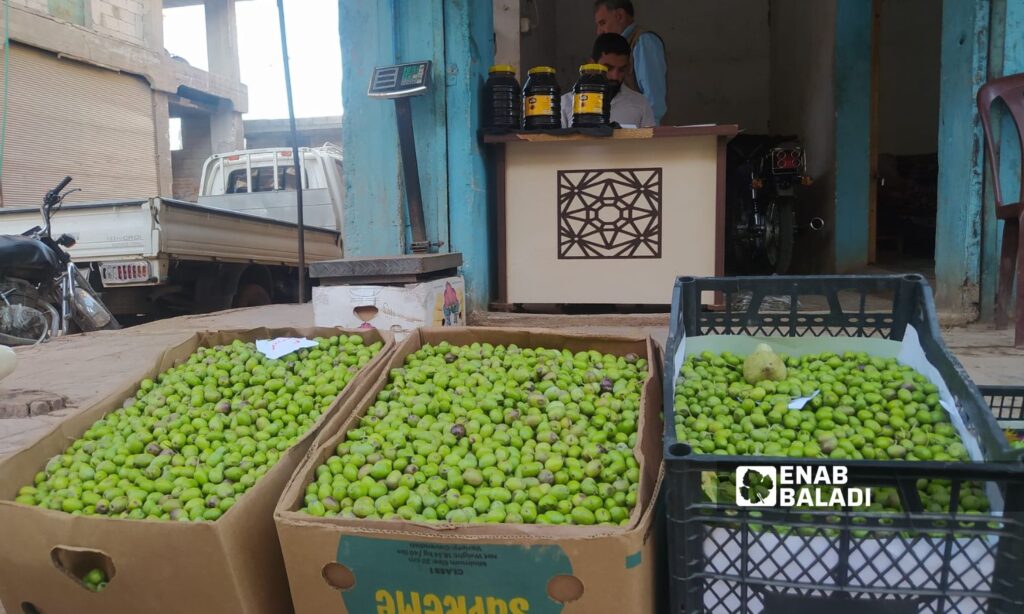Idlib – Shams al-Din Matoun
Farmers in several areas within Idlib governorate began harvesting this year’s olive crop early, a step caused by the escalation campaign launched by the Syrian regime forces in the northwestern region, which led to a new wave of displacement to escape the bombing that caused damage to some olive fields and farms.
The olive crop is usually harvested in the middle of October or after two consecutive rains, which makes the fruits of better quality, especially since most crops depend on rain-fed irrigation. However, some farmers did not wait for the rain to fall and worked to harvest olive fruits in early October. In the past, this contributed to losses for some farmers and caused a decline in the amount of the crop.
A little crop is better than no crop
“A small harvest is better than a complete loss.” With these words, Hassan Kharouf, a farmer from the city of Sarmin, east of Idlib, described the condition of the region’s farmers as he finished harvesting his olive crop a few days ago.
Since the beginning of last month, Kharouf began harvesting olive trees located near the town of Nayrab, where the area is subjected to repeated bombardment by regime forces.
The farmer told Enab Baladi that he took advantage of the calm period that followed the recent escalation to harvest his olive crop despite the weak size of the crop, which could improve after rain or watering it manually.
Kharouf explained that the bombing continued on the city intermittently, which constituted a greater concern of the return of escalation and displacement from the city and the complete loss of the crop.
He pointed out that every 100 kilograms of olives produces about 25 to 30 kilograms of oil when it is time to harvest, while the quantity is declining at the present time due to the incomplete ripening of the fruits and the decline in their quantities.
For fear of the olive crop being stolen
The young man Yahya Abbas, from the town of Killi in the Idlib countryside, finished picking his own crop of olives for this year, which amounts to about 35 trees and is located on the outskirts of the town.
Abbas told Enab Baladi that his family decided to harvest olives after the fruits appeared, without waiting for them to be well filled with oil, pointing out that they found some trees without fruits, meaning that they had been stolen before they ripened.
Although this harms the production of the crop, it has become an urgent necessity, Abbas said, for fear of theft, given the spread of dozens of informal camps, and some damage is sometimes caused to olive trees as a result of the spread of sheep herders around the area.
The young man explained that harvesting the fruits before the rains makes it difficult, as the branches are dry and the olives do not fall easily, which constitutes additional obstacles for the harvesters, and he does not collect abundant quantities of olives.
Quality affected
Agricultural expert Abdulwahab al-Ali told Enab Baladi that the olive harvest season begins after sufficient rainfall for irrigation because most olive orchards are rainfed and need rainwater before harvesting.
According to al-Ali, the weight of the olive tree ranges between 20 and 50 kilograms on average, and production varies according to the age of the tree, service operations, weather conditions, and harvesting date. The quality of the oil is also affected by the variety, soil, and service operations such as cultivation, fertilization, and irrigation.
He explained that in the case of early harvesting, the quality of the oil is high in terms of chemical properties, but the quantity of the oil is less.
However, in the event of a delay in the harvesting process, the chemical properties of the oil decrease and its quantity increases, while at the appropriate time of harvesting without early or delay, high-quality oil can be obtained and in an appropriate quantity.
880,000 trees in Idlib
The general directorate of agriculture of the Syrian Salvation Government (SSG), the local governing body in Idlib, estimated the number of olive trees at about 880,000 trees.
Tamam al-Hamoud, director of the agriculture directorate, told Enab Baladi that the expected production for this year is 115,000 tons, while the market need is estimated at 13,000 tons for pickling and the rest for pressing.
It is expected that olive oil production will reach 22,000 tons, with expectations that the region’s need for the material will be equivalent to 13,500 tons.
According to al-Hamoud, the types of trees grown in the regions of northern Syria are of high quality and good production, and this year’s production will be of high quality, given that the season is not affected by diseases such as olive fruit fly, due to the high summer temperatures.

